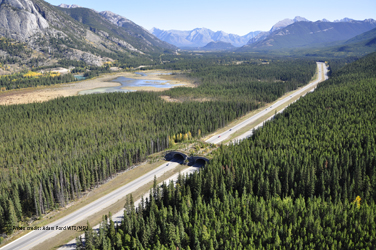The use of wildlife road-crossing structures (WCS hereafter) is less monitored for small mammals than for more emblematic species. Furthermore, because of the undeniable difficulty of small mammal track identification, most biologists usually carry out general surveys without species recognition. Here it is hypothesized that general surveys traditionally used for monitoring WCS by small mammals may be biased because the degraded habitats along roads are mainly used by generalist and not specialist species. For this reason, authors compared the results of a general small-mammal survey with those from a species-specific one, focusing on 3 study species: 1 habitat generalist (North American deer mouse), 1 forest specialist (southern red-backed vole), and 1 prairie specialist (meadow vole). We sampled along 4 types of WCS (overpasses, open-span underpasses, and both elliptical and box culverts) in Banff National Park (Canada), by placing footprint track tubes along the WCS, and as a reference in front of their entrances (mainly located in roadside grasslands) and in the surrounding woodlands. Using the traditional general survey, significant differences in small-mammal presence among WCS and reference sites were not detected. In contrast, species-specific surveys showed that only the deer mouse (a generalist species) consistently used the WCS. The deer mice did not show preferences for any WCS type, whereas the specialist species (voles) used only overpasses. Therefore, general surveys used without species identification can overestimate the value of WCS for specialist small mammals, with relevant conservation implications. As a consequence, species-specific surveys of WCS suitability for small mammals is recommended. Authors also suggest improving the habitat (or at least the cover availability) in the WCS and along the space between them and the surrounding environments to increase WCS suitability for specialist species. informacion[at]ebd.csic.es: D'Amico et al (2015) General versus specific surveys: estimating the suitability of different road-crossing structures for small mammals. J Wildl Manage 79(5) 854–860 DOI: 10.1002/jwmg.900
http://onlinelibrary.wiley.com/doi/10.1002/jwmg.900/abstract


 Las altas temperaturas están provocando que las lagunas y las marismas de Doñana pierdan agua rápidamente
Las altas temperaturas están provocando que las lagunas y las marismas de Doñana pierdan agua rápidamente




